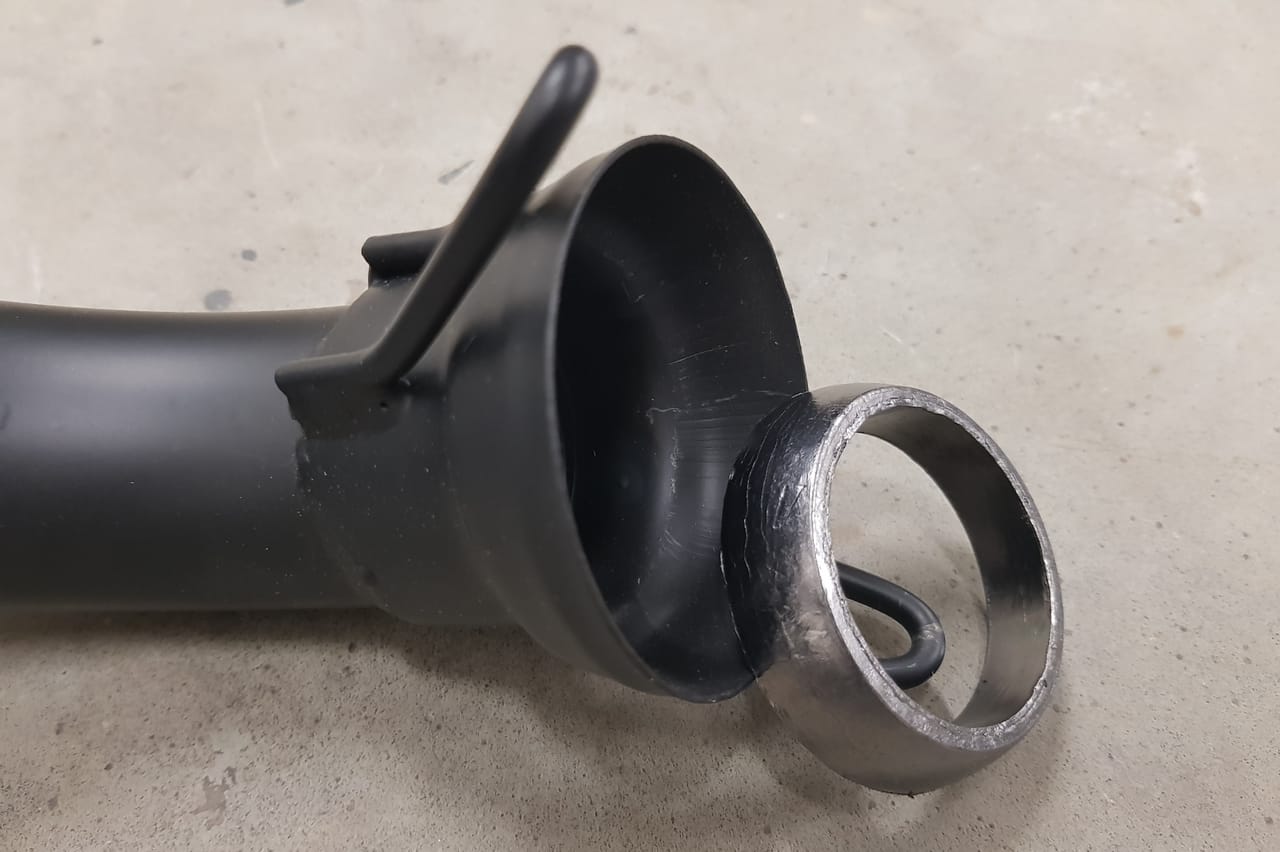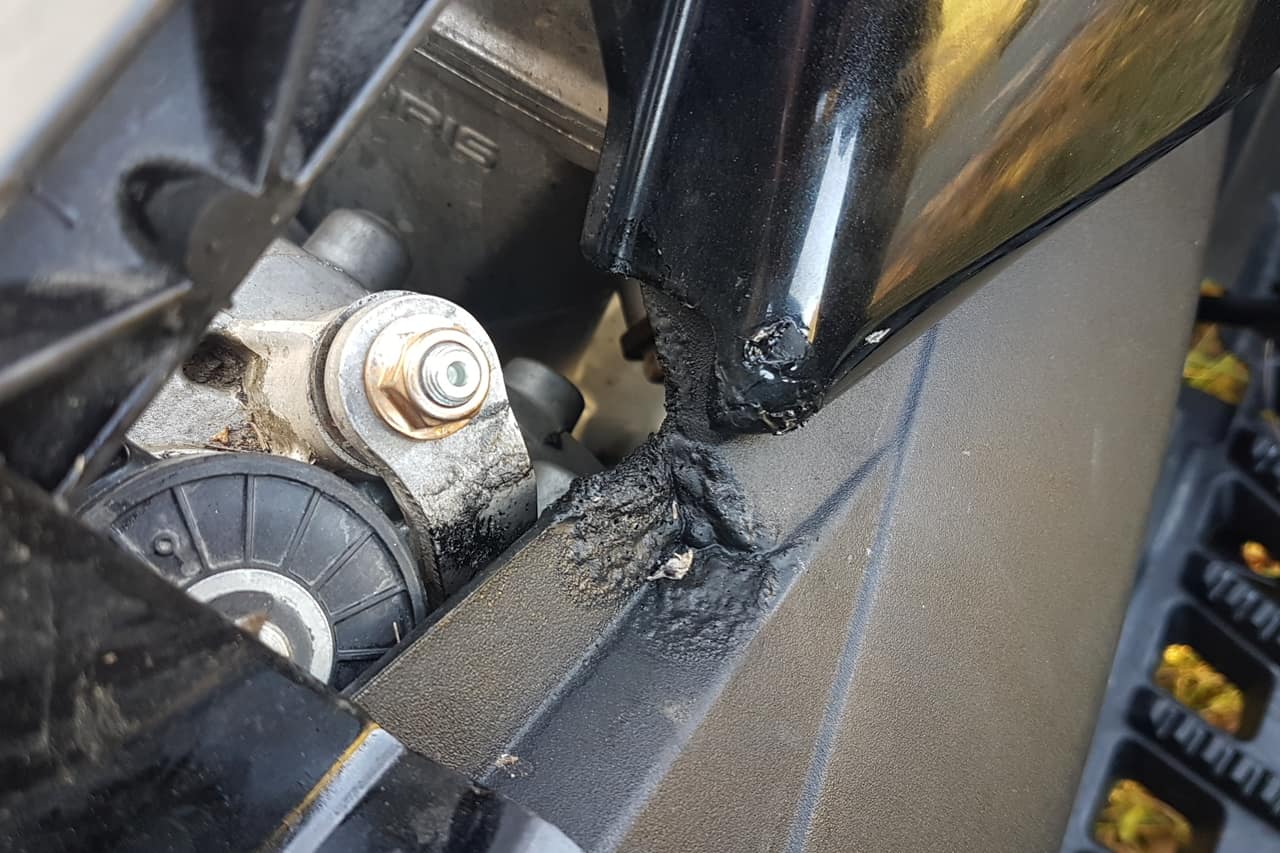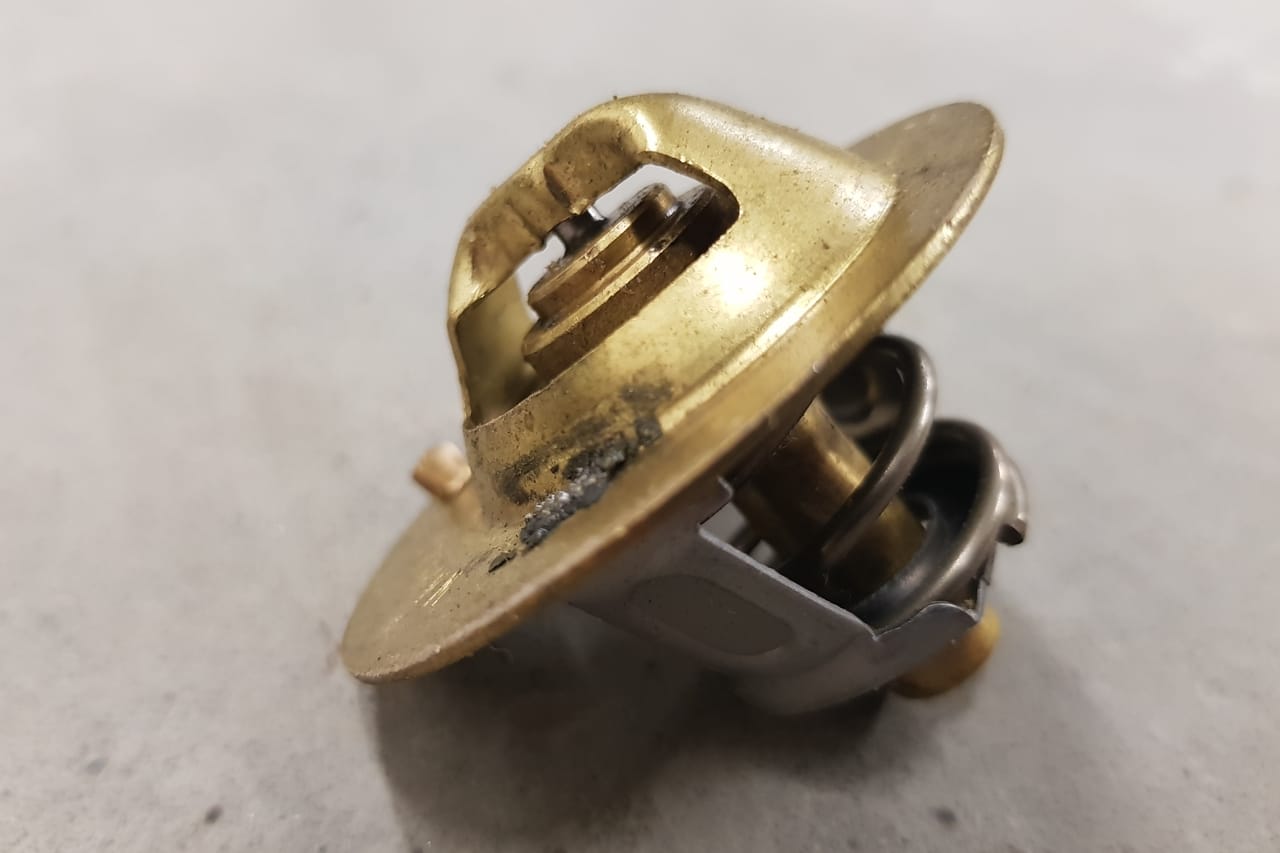Picture this: You just returned home from an intense ATV trail run when you notice the exhaust glowing red hot. You naturally start worrying whether this is normal or not.
A glowing red color in the ATV exhaust pipes is usually an indicator of fire-bursting temperatures, which is rarely a good sign, especially when it involves our expensive toys!
Any ATV will generate a lot of heat when you push it to its limit. And this heat needs to go somewhere.
When something prevents the bike from getting rid of this heat as it should, or if some issue makes it produce more heat than it is designed to handle, heat will start building up in the exhaust system.
Related: ATV Overheating (Symptoms, Causes, and How to Prevent)
Why Do the Exhaust Pipes Glow Red?
The exhaust glows red when the metal heats up to where it’s getting closer to its melting point. But there is no risk of the metal actually melting, as this requires quite a bit more heat, even from the point where it is visibly glowing red.
The glowing happens at different temperatures, depending on the metal your exhaust is made of. Stainless steel, for example, will glow at a much lower temperature than non-stainless.
So determining the actual temperature solely by the glowing color is inaccurate. A temperature gauge is needed to get the correct readings.
During the day, you will, in most cases, barely be able to see the glowing. And if you do, it will look more like a dark red. But in the dark, the same temperature will make it glow bright orange.
Does Glowing Red Exhaust Always Indicate an Issue?
Before we get into the actual causes of why your exhaust glows red, you should know that some heat-related color changes are perfectly normal on many ATVs.
The first part of the header, or up to the first bend of your bike’s exhaust, may start glowing if you push it hard enough. This does, however, not necessarily indicate something is wrong with the bike. It will not hurt anything.
But if the exhaust glows beyond the first bend, you probably have a problem that needs to be addressed.
I cannot tell you what is typical on all ATVs, so if you want to be sure everything is okay, your dealer should be able to tell you how your specific bike should behave.
However, if the color suddenly starts changing, it’s a good indicator that something is wrong.
Suppose you know that previously, only the first few inches of the exhaust used to become slightly red. But then, one day, you notice a larger pipe area is affected, and the color has changed to bright orange, almost white.
This means something has changed, and it would be a good idea to locate what’s causing this change before it gets any worse.
Common Reasons for a Glowing Red-Hot ATV Exhaust
So let’s dive into the potential causes of your glowing ATV exhaust pipes.
1. The Engine Is Running Too Lean
If the bike, for some reason, does not get as much gas as it needs, it will still run, but it will be running too lean. This condition where the bike does not get enough fuel and too much air can cause a furnace effect.
This will generate more heat, with a glowing exhaust as the most visible consequence. Another possible result of running the bike in this condition is that it will burn a hole in your aluminum piston over time.
In the worst case, you seize the piston entirely, causing potentially severe damage to the cylinder assembly.
After reading countless forum posts, articles, and other relevant sources, I’m confident that the engine running too lean is the most common reason for glowing red ATV exhausts.
To complicate things even further, there are a handful of possible causes of the engine running too lean.
How to Tell if the Bike Is Running Too Lean?
There are several ways you can go about determining whether the bike is running too lean or not.
Start by taking it out for a couple of passes. If the bike, when you let off the throttle, makes loud and hard popping/cracking sounds, almost like firecrackers, it is likely to lean on the idle/pilot circuit.
This popping is often referred to as the bike backfiring. And while some popping is perfectly normal, you may want to look into it if it gets too loud and hard-sounding.
Loud backfiring is usually a good sign of the ATV running too lean.
Another way to tell if the bike is running too lean, just by riding it, is the idle hangs. This means that when you let go of the throttle, the RPMs do not drop immediately as you would expect. Instead, it “hangs” slightly on higher RPMs. The bike may use several seconds to get itself back down to idle.
Inspecting the Spark Plugs to Tell if the ATV Runs Lean
- Start by taking a quick ride to get the ATV up to operating temperature.
- Then remove the spark plug or plugs to clean them. Use a copper wire brush and a rag to get it completely clean. Be careful not to bend the metal arch, which will damage the plug.
- Also, wipe down the area around the cylinder head using the rag. Be careful so you don’t get any debris inside the cylinder.
- Reinstall the spark plug and go for a short ride of only a few hundred meters on full throttle. Ideally, this should be done uphill to add even more load.
- Stop and remove the spark plug. Use a glove and be careful; it is scorching hot!
- Inspect the plug. If the bike runs too lean, you should see a whiteish color on the tip of the plug and no visible moisture (oil or gas). If the bike runs extremely lean, the plug’s tip starts to melt. On the other hand, if the plug is slightly wet but otherwise clean, your settings are likely okay. The color should be grey to brownish with little zoot.
Related: ATV Keeps Fouling Spark Plugs – Common Causes and Symptoms
ATV Running Lean Because of a Dirty Carburetor or Jets
So you’ve determined that the engine is running on the lean side. If the ATV is otherwise stock, you should start by cleaning the carburetor to eliminate the chance of a plugged or partially plugged jet.
Remove each jet to clean them individually. Use spray cleaner, a copper brush, and compressed air to ensure they are entirely open. Soaking them in a cleanser is often insufficient to get a good result in cleaning the tiny passages, especially for the pilot jets.
Dirty pilot jets would also cause lean idle problems.
ATV Running Lean From Wrong or Non-ideal Jetting
If you’ve determined that the jets are clean, you may need to change them up a size or two to allow a higher fuel flow.
Be aware that many ATVs run a bit lean from the factory. They are set up like this to meet emission standards.
Buy and install a jet kit, and you won’t be surprised if your glowing exhaust improves by quite a bit, if not completely disappears.
ATV Running Lean Because of Cracked Vacuum Lines
Damaged vacuum lines will also make the engine run lean. These are easy to visually inspect and fast and cheap to replace.
2. Dirty, Damaged, or Poorly Adjusted Exhaust Valves
The exhaust valves inside your engine close when ignition happens, then open to let the exhaust gasses out on the next stroke. This process occurs continuously at high speed when the engine is running.
Over time, carbon residue may build up on the valve head, making for an un-tight seal. This will allow hot air and flames from the explosion to exit through the gap when the valve is supposed to be closed entirely.
The same applies if the valve is (significantly) out of adjustment or even damaged, making it not close the exhaust port completely when it should.
These issues require the cylinder head to come off for inspection, adjustment, or cleaning. If the thought of an oil change freaks you out, now would be a good time to call your mechanic.
You can try performing a compression test to test if your valves are good. The compression should be lower than the manufacturer’s specs.
An even more accurate way is to perform a so-called leak-down test.
3. Exhaust Leak
Exhaust leaking before it exits the system will reduce back pressure, which may cause the bike to run hot.
Look for loose clamps, damaged donut gaskets, or even holes or cracks in the pipe. Repair or refit to see if this improves things.

4. Using Aftermarket Exhaust Systems
Aftermarket exhaust systems and headers are usually made of different materials than stock systems. As we’ve already looked at, a system made of stainless steel will glow at lower temperatures than non-stainless.
On top of that, they usually use thinner walls to save weight. This means less physical mass to heat up, resulting in a brighter glow.
On the other hand, aftermarket systems will usually give you much better exhaust flow. This allows the heat to exit the system much faster, making for an overall much cooler system.
5. Poor Airflow When Standing Still and Idling
The exhaust pipes only cooling is from the air passing by as you ride.
When the bike stands still, so will the air around the exhaust, and there will be almost no cooling. This makes it much harder to keep the temperature of the header and the exhaust down.
Even if the bike produces more heat when riding, you may find that the glowing gets worse when standing still at idle. This shows how vital the airflow is to keep the system cool.
So if your exhaust is glowing red when idling at a standstill, it may just be due to insufficient cooling.
6. Clogged Exhaust Pipe or Muffler
If something is restricting airflow somewhere in the exhaust system, you” get excessive back pressure where heat will build up instead of escaping as hot air.
Luckily, this one may be a cheap and easy fix that should be ruled out early in the troubleshooting process before you start looking into the more severe causes.
Start by having a look inside the opening of the rear muffler. If the bike has a spark arrester fitted, it may have become dirty and needs a good cleaning not to restrict airflow.
Also, look for mud or some other debris clogging the pipe. If you’ve been riding in deep mud and stopped the engine, dirt may have gotten inside the system. In this case, you need to disassemble everything to clean the inside of the exhaust.
If the bike has been parked for some time, you should also consider the possibility that some critter has made a new home of your exhaust. Mice tend to like dark cozy places when nesting to give birth. Your bike exhaust may have become a delivery room for the little buggers.
I’ve not had this happen with mice, but when we start preparing the different implements on the farm in the springtime, it’s common to find bird nests in the strangest places.
Because of stringent sound emission regulations, bikes sold in my home country (Norway) are often fitted with extra large and stuffed mufflers compared to US markets. The exhaust flow suffers badly from this, keeping the heat trapped inside the exhaust system.
Story-time:
On a friend of mine’s XP-1000, flow restriction had the unfortunate effect of setting the bike on fire!
He was riding at low speeds, hauling a moose out of the woods, using an ATV trailer. The exhaust got so warm that the plastic ignited.

Luckily he had a bottle of tea at hand and could put out the fire before it had time to spread. The dealer wanted to solve the issue by adding more heat shields.
He instead chose the option of installing an aftermarket exhaust, allowing for much better airflow. The glowing exhaust disappeared immediately.
7. A Faulty Thermostat
This is probably not the most common reason why your exhaust is glowing, but if you are experiencing heat issues, ensuring the thermostat functions as it should always be a good thing.
A properly functioning thermostat will open at a given temperature, allowing coolant to flow through the radiator.
However, these things are prone to fail because of corrosion or other reasons. Luckily they are cheap and easy to replace. So when in doubt, you don’t waste by installing a new one, even if it is not the cause of your issues.

The coolant does not cool the exhaust directly but keeps the overall engine temperature low. When the system is not functioning correctly, you will get a higher engine temp, resulting in a bigger chance for a glowing red hot exhaust system.
To test the thermostat, you disassemble it and bring it to your kitchen. It is best to do this job when you are home alone, and don’t risk explaining yourself to your significant other.
Put the thermostat in a casserole with clean water and heat it until it boils — no stirring necessary. You should be able to see clearly when the thermostat opens, usually just before the water starts boiling.
If you have the specs for your thermostat, you can use a thermometer to see if it opens at the correct temperature.
If nothing happens, the thermostat is faulty and needs replacing.
Related: ATV Coolant Flushing – Everything You Need to Know
8. Blocked or Restricted Air Intake
Check if something is obstructing unrestricted airflow through the airbox. Also, look at the intake boots and inspect for any cracks or loose clamps that could give you an air leak.
The rubber boot between the carburetor and the cylinder is also prone to cracking when it starts aging. If it’s broken, it’s best to replace it.
A temporary fix I’ve used with good results is putting some Tec7 Multibond in the crack until I can get a hold of a replacement. Do not ride the bike until the sealant has healed completely.
9. Weak or Intermittent Spark
If the spark is too weak or intermittent, you won’t burn all the fuel, and you get incomplete combustion. If the unburned fuel does not ignite until it enters the exhaust, a red-hot exhaust is to be expected.
10. Glowing Exhaist in the Winter
When temperatures are low, the air will be denser, causing the ATV to run in a more lean state.
If the bike was already running on the lean side in the summer, using it in the winter may be what tips the scale for becoming too lean.
Fuel-injected bikes should not have this issue as they automatically compensate for different operating temperatures. But if your bike is equipped with a traditional carburetor, it may be worth looking into.
If this is the case, you may need to re-jet the bike. An alternative to changing jetting between summer and winter conditions is to set it up to run a bit rich in the summer. This should ideally allow the quad to run fine all year round.
11. Using the Wrong Type of Spark Plugs
Using the wrong spark plug type may make your engine run hotter than expected.
Different spark plugs operate at different temperatures, so it’s crucial to get the right ones according to your bike specs.
You will find the correct numbers in your owner’s manual.
12. ATV Running Too Rich
This one is almost a non-issue nowadays now that we have fixed jetting.
But back in the days when we had adjustable main jets, you could mess up the adjustments so badly that unburned fuel was sent down into the muffler, where it would continue to burn.
In this case, your muffler would glow like the sun on a hot summer’s evening.
